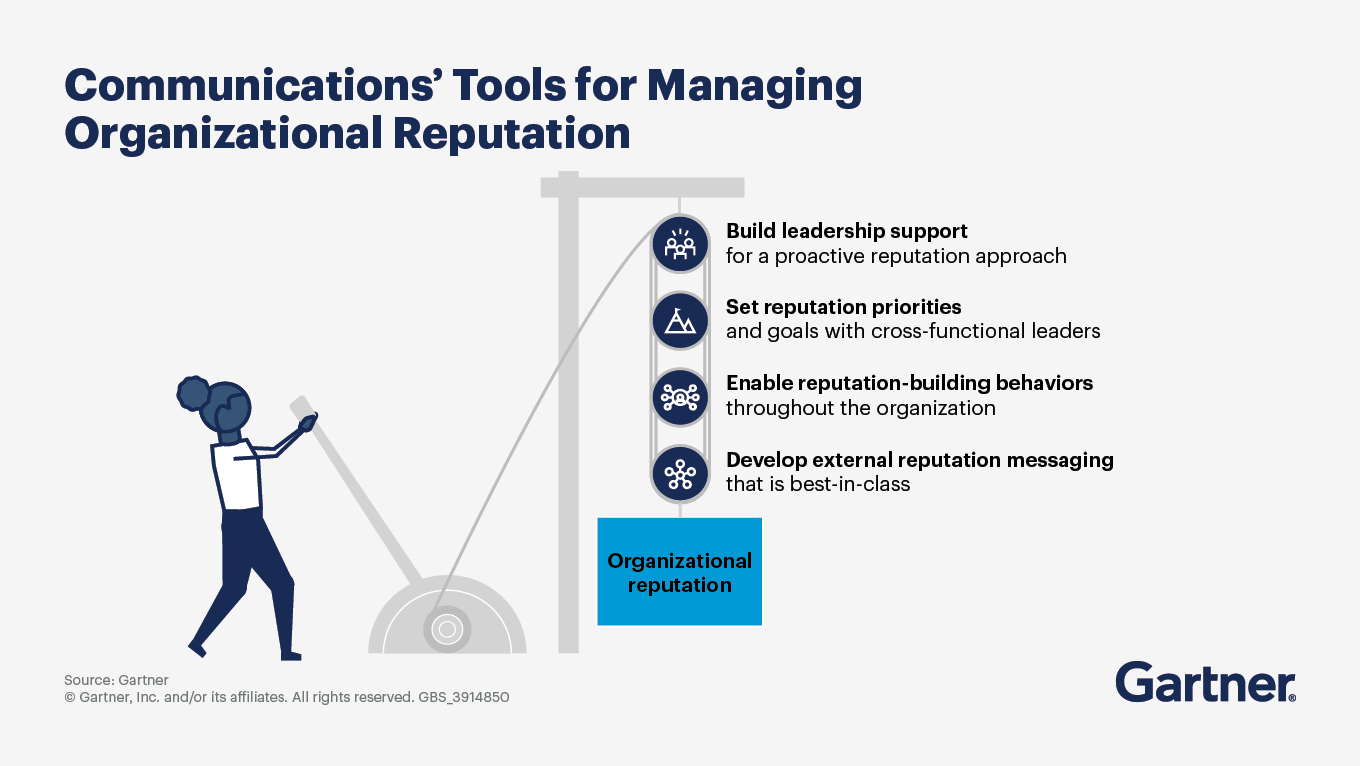Shift from crisis response to long-term reputation strategy — and strengthen stakeholder trust along the way.
- Gartner client? Log in for personalized search results.
Be proactive: Safeguard your reputation before a crisis
Organizational reputation is difficult to define, harder to measure and increasingly shaped by forces both inside and outside the business. Reputation is the collective perception people form based on what they see, hear and experience — not just from the company itself but from everything around it. As communications leaders face rising stakeholder expectations and greater public scrutiny, reputation management demands a more strategic, proactive approach.
4 tools communications leaders need to leverage organizational reputation
Reputation management isn’t just about damage control. Organizations that actively build and strengthen their reputation are better positioned for long-term business success.
Build leadership support for a proactive reputation approach
Many leaders only prioritize reputation when a crisis hits, which makes it tough for brand leaders to gain support during more stable periods. And we all know you can’t PR your way out of a bad reputation, which is why buy-in for proactive efforts is so important. So when other leaders position a good reputation as a “nice to have,” explain the connection between negative perceptions and slow business — fewer customers will want to buy from you if they don’t trust you or your products. Other leaders may think that reputation management is solely the brand leader’s job. Explain that, in actuality, a strong reputation requires organizationwide effort.
Set reputation priorities and goals with cross-functional leaders
A poor reputation can quickly undermine your business success if left unaddressed. Yet choosing the right reputation management initiatives can be challenging, especially when the definition of a “good” reputation evolves. The best way to combat this is to zero in on what matters most to your target stakeholders. Do they highly prioritize sustainability efforts? Are they concerned with community involvement? Work with cross-functional stakeholders to balance these priorities with drivers your company excels at. This will ensure your reputation efforts directly support your business strategy.
Enable reputation-building behaviors throughout the organization
A positive reputation requires ongoing organizationwide effort. It’s important to keep brand perception and reputation top of mind. Some companies send out regular reports on reputation risks and opportunities to keep leadership informed. But all employees should be doing what they can to protect their company’s reputation. With hybrid work environments, there might be less transparency when it comes to what puts the organization at risk, so it’s up to leaders to correct that. Empower employees to speak up if they see something that could harm the company’s reputation. When difficult decisions arise, help teams understand the balances and trade-offs between business impact and company values.
Develop best-in-class external reputation messaging
Effective external communications are about more than raising awareness –– they’re about shaping how audiences perceive your company. Identify the underlying beliefs your audience has about your organization, then craft messages that address and, if necessary, reshape those perceptions. Highlight your company’s social impact campaigns — each commitment your company makes should have a sense of personal involvement. Lastly, when it comes to messaging, ensure your PR leaders are trained to create compelling brand narratives that cut through information overload and resonate with your audience.
Reputation management FAQs
What is organizational reputation?
Organizational reputation is the collective perception that stakeholders — such as customers, employees, investors and the public — have about a company. It’s shaped by what people see, hear and experience about the organization from direct interactions and external sources.
What is reputation management?
Reputation management is the strategic process of influencing and guiding how an organization is perceived by its stakeholders. It involves monitoring public sentiment, addressing risks, promoting positive narratives and aligning internal behaviors with brand values.
How is reputation different from brand?
While closely related, reputation is how people perceive your organization based on experiences and external influences, whereas brand is how your organization intentionally presents itself through messaging, design and identity. Reputation is earned; brand is built.
Who is responsible for managing organizational reputation?
Everyone in the organization plays a role in managing organizational reputation. While communications and PR teams may lead strategy, reputation is shaped by leadership decisions, employee behavior, customer service and even supply chain practices.
Can a damaged reputation be repaired?
Yes, but it takes time, transparency and consistent action. Rebuilding trust requires acknowledging issues, demonstrating accountability and showing meaningful change over time.
Attend a Conference
Accelerate growth with Gartner conferences
Gain exclusive insight on the latest trends, receive one-on-one guidance from a Gartner expert, network with a community of your peers and leave ready to tackle your mission-critical priorities.

Drive stronger performance on your mission-critical priorities.
